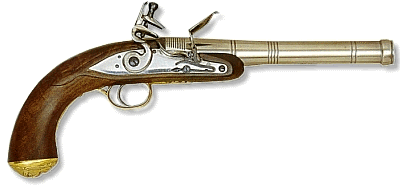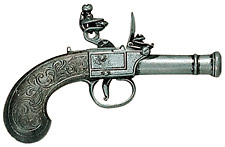 |
|
The Pride of a Soldier in his majesty's royal service...
Explore the world of projectile combatives below:
Projectile weapons were typically weapons of the wealthy upper class and most often
the military soldier and officer. The longarm and sidearm only came into common use in the
later half of the Eighteenth Century.
All men were encouraged to enlist with the British army, especially
youths who attended the public schools, so that they may perform their
duties to their country as well as their king. The training of a British
soldier was very specific and rigorous. The specifications for dress,
conduct, and obedience to authority were very strict. (The Militia
Man) Officers were trained in military schools, but there were also
manuals, which outlined the requirements and training processes for those
who were interested in joining the army. (The Soldier's Companion)
Although soldiers were trained to use many weapons, the musket,
rifle, and bayonet combination was most often used by the lower ranks.
Officers preferred the pistol and small-sword or sabre.
Learn more about the Eighteenth Century British Soldier...
The Musket:
The Musket was mainly issued to and used by the infantry in the British
army. This weapon resembles the modern rifle of today, except that it was
a muzzle loading weapon, meaning that the shot and powder were poured
into the barrel. It had to be loaded vertically, therefore, a soldier
had to load it standing up. The "Brown Bess" was what the
commonly used English musket was named, and it was fairly heavy and
inaccurate. This was not very important, however, because it was only
fired at a crowd of soldiers at the enemy's line in this type of combat it was very effective. (3)
 Brown Bess c. 1797 Brown Bess c. 1797
The Rifle:
Rifled muskets were not very common and generally only given to the best
marksmen or regiments in the army because they could
use it to its best advantage.
This early 'rifle' was still a muzzle-loading weapon like the musket. The
disadvantages to them being they were slower to load, as the ball was a
tighter fit into the barrel because the inside of the barrel was not
smooth. Ironically this was the rifles advantage as well. The scored barrel allowed
the ball to spin and increase its accuracy.
Also, since it was shorter than the musket, a soldier could load it lying down. The
'Baker' was the most popular and commonly used rifle of the period.
 Baker Rifle Baker Rifle
The Pistol:
The Pistol was much lighter and easier to carry than the musket and
rifle; hence they were often the choice of weapon preferred by officers and as well as that to be carried by a
civilian should he chooes to do so, especially for use in a duel. Just like the other firearms,
reloading could be a lengthy process, and only one bullet could be fired at
a time. In combat, when there was not enough time to reload, the butt of
the gun was used as a club. (City of Edinburgh Museums and Galleries)
 The Long Pistol The Long Pistol
 The short Pistol The short Pistol
|
|
|
|